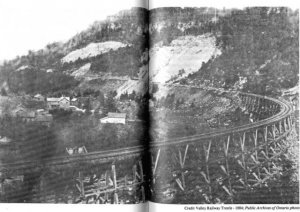Hello, can someone please give me advice as to trestle construction over rivers.
I am modelling 1900 circa. I was wondering what the common construction method was back then for building trestle bridges that spanned small-medium rivers. eg. a river in a canyon or gully.
Would the "bents" stop either side of the river, or would the bents continue as normal and be sunk into the river bed.
I hope I am making myself clear.
In other words, I want to know if bents would be sunk into a river bed, or whether the trestle bridge would form a gap where the river passed under them and then continue with bents on the other side of the river ?
Thanks for any advice and / or pics.
I am modelling 1900 circa. I was wondering what the common construction method was back then for building trestle bridges that spanned small-medium rivers. eg. a river in a canyon or gully.
Would the "bents" stop either side of the river, or would the bents continue as normal and be sunk into the river bed.
I hope I am making myself clear.
In other words, I want to know if bents would be sunk into a river bed, or whether the trestle bridge would form a gap where the river passed under them and then continue with bents on the other side of the river ?
Thanks for any advice and / or pics.


